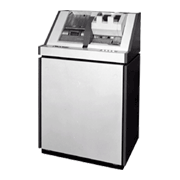Oki Electric Industry's first mark card reader was announced in 1969. It was developed as a replacement for the previous system, where an operator punched the original information into paper tape or cards, which were input to the computer. With a mark card reader, the original information was marked with a pencil on a paper card at the time it was created, and was then input to the computer.
In reading a mark card, the system detected the presence of a mark with reflected light. Things like soiling of the paper surface and residues left after erasing with an eraser decrease reflectance, so in order to greatly reduce the effects of these factors, Oki developed a detection circuit for this reader which amplified the difference between reflectance at a marked part, and reflectance of the paper surface.
| OKI MARK CARD READER | ||
|---|---|---|
| Read speed | 100card/min | |
| Read system | Reads reflected light using silicon photoelectric element (column-by column vertical) | |
| Cards | Low luster paper, with white uniform surface having reflectance of 70% or more | |
| Mark position | Column spacing: 4.42mm, Number of columns: 40, Max. number of marks in 1 column: 12 | |
| Printing | To be read | Black non-reflective ink for timing marks and special function symbols etc. |
| Not to be read | Thin reflective ink for background, such as mark positions and format designation characters etc. | |
| Mark | Marking | Make line in column direction inside designated frame, using a black pencil with a density of HB or higher |
| Erase | Completely erase with clean eraser | |
| Card hopper capacity | 500card | |
| Card stacker capacity | 500card | |
| Power supply | 50 or 60Hz, AC100V±10%, Approx. 650VA | |
| Dimensions | 700(W)x470(D)x1120(H)mm | |
| Weight | 160Kg | |


